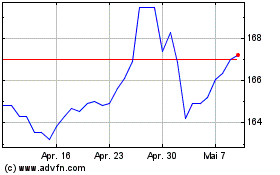Currency Movements Highlight Monetary Policy Divergence
23 Januar 2023 - 10:08AM
RTTF2
Currency movements during the week spanning January 16 to 23
brought to the fore the wide divergence between monetary policy
approaches pursued by major central banks.
While the steady decline in inflation provided the Fed with
ammunition to taper the rate hikes, it appeared to be hesitant and
slow in obliging with a quick dovish pivot. The European Central
Bank in the meanwhile reiterated its allegiance to the goal of
fighting inflation, amidst warnings of significant rate hikes at a
steady pace. The Bank of Japan on the contrary, persisted with its
ultra-easy monetary policy stance, despite widespread expectations
to the contrary.
Increasing expectations that the Fed would soon tone down its
harsh monetary policy strategy, dragged down the Dollar against
major currencies in the past week. Hawkish comments by Federal
Reserve officials could not suffice to shore up sentiment in favor
of the greenback. The Dollar Index (DXY), a measure of the Dollar's
strength against major currencies viz Euro, British Pound, Japanese
Yen, Canadian Dollar, Swedish Krona and Swiss Franc weakened to
102.01 by January 20, from 102.20 at the end of the previous week.
The DXY ranged between a high of 102.90 and a seven-month low of
101.53 during the past week.
The Euro benefitted from the European Central Bank's continuing
aggressive monetary policy stance as well as comments by its
officials. The European Central Bank President Christine Lagarde
affirmed in Davos that inflation in the region continued to be far
too elevated, and that policymakers would not let up in their
efforts to return price growth to the targeted level. The Euro
strengthened from the $1.0828 on January 13 to $1.0855 by January
20. The EUR/USD pair touched a high of 1.0889 and a low of 1.0766
during the past week.
The pound's strength in the past week too was attributed to the
fears surrounding the rate hike by the Bank of England in the
ensuing meeting. Data released during the week had shown
unemployment steady at 3.7 percent, reinforcing the strength of the
job market that warranted strong action by the Bank of England to
quell price pressures. The British pound which touched a weekly-low
of $1.2169 on Tuesday strengthened to touch the weekly-high of
$1.2437 by Wednesday. During the past week, the GBP/USD pair
increased to 1.2393, from the level of 1.2226 at the end of the
previous week.
In the past week, the USD/JPY pair oscillated between 127.22 and
131.59. The yen, which had strengthened amidst widespread
expectations of a hawkish tilt by the Bank of Japan, plunged after
it came to be known that the central bank had not moved to expand
its yield curve control or shift from its ultra-dovish monetary
policy stance. The disappointment caused the yen to weaken against
major currencies, pushing up the USD/JPY pair to 129.57, from
127.88 a week earlier.
The PCE-based inflation readings from the U.S. are due on
Friday, and markets are waiting to see whether the Fed's preferred
inflation gauge corroborates the declining trend on display in the
CPI. The Fed would hand over its next interest rate decision on the
first of February while the Bank of England and the European
Central Bank would follow a day later. Based on the monetary policy
expectations already priced in, the Dollar Index (DXY) is currently
at 102.16. The EUR/USD pair is at 1.0852, the GBP/USD pair at
1.2337, and the USD/JPY pair at 130.63.
Euro vs Yen (FX:EURJPY)
Forex Chart
Von Mär 2024 bis Apr 2024

Euro vs Yen (FX:EURJPY)
Forex Chart
Von Apr 2023 bis Apr 2024
